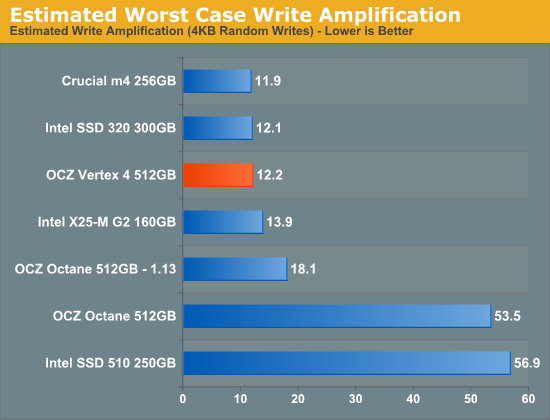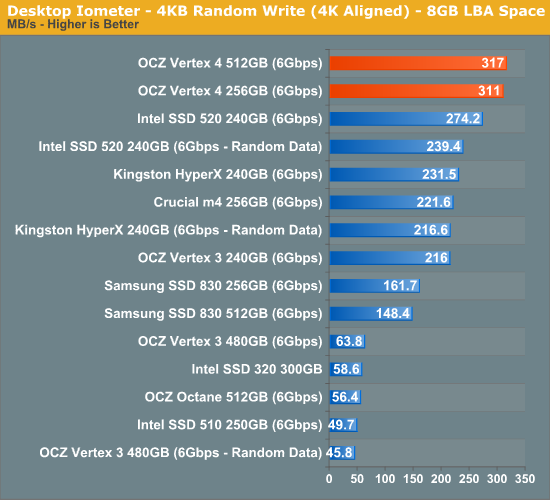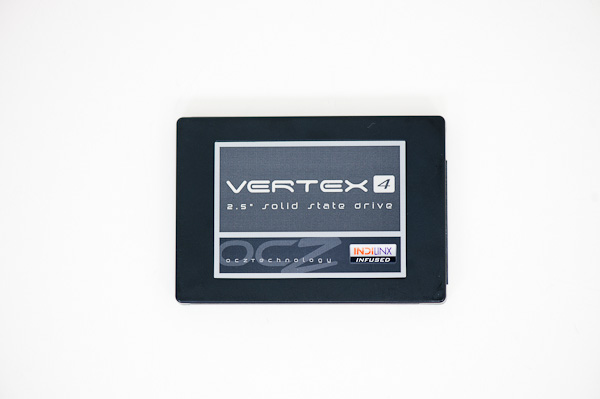OCZ Vertex 4 Review (256GB, 512GB)
by Anand Lal Shimpi on April 4, 2012 9:00 AM ESTThirteen months ago OCZ announced its intention to acquire Indilinx, the SSD controller maker that gave Intel its first taste of competition in the consumer market in 2009. Eight months later, OCZ launched its first post-acquisition SSD based on Indilinx silicon. Today, just five months after the launch of the Octane, OCZ is officially releasing the Vertex 4 – based on its Indilinx Everest 2 silicon. In less than a year, OCZ has brought to market more Indilinx powered controllers than Indilinx did in the previous three years. It's rare that you see the fruits of acquisition so quickly, but if there's anything OCZ's CEO Ryan Petersen is good at it's pushing for an aggressive schedule.
Rather than call this drive the Octane 2, OCZ went with Vertex 4, indicating its rightful place at the top of OCZ's SSD lineup. The implications run even deeper. It marks the first time in two years that a Vertex drive will ship without a SandForce controller inside. Make no mistake, while Octane was a shot across SandForce's bow, Vertex 4 means war. While OCZ continues to ship tons of SandForce controllers, the future for the company is Indilinx. The Vertex 4 is just the beginning. OCZ will continue to ship Vertex 3 in parallel, and should a future SandForce controller make competitive sense to use OCZ will definitely consider it, but the intention is to build the fastest silicon internally and use it as much as possible.
The dramatic departure in naming also embodies just how different Everest 2 is from the original Everest controller. OCZ claims there's minimal shared code between the Octane and Vertex 4 firmware, and the two drives perform very differently. Write amplification was always a concern with the Octane - it is no longer a major issue with the Vertex 4. OCZ and its Indilinx team have reduced write amplification to roughly the levels of Intel's controllers:

Indeed write performance is improved significantly as a result. A look at the spec sheet gives us the first indication of what's to come:
| OCZ SSD Comparison | ||||||
| OCZ Vertex 4 | OCZ Vertex 3 | OCZ Octane | OCZ Vertex 2 | |||
| Current NAND | 25nm IMFT MLC | 25nm IMFT MLC | 25nm IMFT MLC | 25nm IMFT MLC | ||
| Capacities | 128, 256, 512GB | 60, 90, 120, 240, 480GB | 128, 256, 512GB, 1TB | 60, 120, 240GB | ||
| Controller | Indilinx Everest 2 | SF-2281 | Indilinx Everest | SF-1221 | ||
| Max Seq Read | 535 MB/s | 550 MB/s | 480 MB/s | 285 MB/s | ||
| Max Seq Write | 475 MB/s | 500 MB/s | 330 MB/s | 275 MB/s | ||
| Max Random Read | 95K IOPS | 60K IOPS | 26K IOPS | - | ||
| Max Random Write | 85K IOPS | 85K IOPS | 35K IOPS | 50K IOPS | ||
| AES-256 Encryption | Yes | Yes | Yes | No | ||
Regardless of the nature of the data (compressible or incompressible), the Everest 2 powered Vertex 4 promises better random write performance than any other consumer SSD on the market today. And it delivers:

Random write speed is nothing short of incredible. OCZ is able to equal SandForce's write speed on highly compressible data without resorting to any sort of data compression. This is a purely algorithmic advantage. While the original Everest was a work in progress by the time OCZ acquired the company, Everest 2 is the first Indilinx project OCZ had complete control over. Apparently OCZ's CEO, Ryan Petersen had a lot of his own input built into this design.
| OCZ Vertex 4 Lineup | |||||
| 512GB | 256GB | 128GB | |||
| NAND Configuration | 16 x 32GB 25nm Intel sync NAND | 16 x 16GB 25nm Intel sync NAND | 8 x 16GB 25nm Intel sync NAND | ||
| DRAM | 2 x 512MB DDR3-800 | 2 x 512MB DDR3-800* |
2 x 512MB DDR3-800* | ||
| Controller | Indilinx Everest 2 | Indilinx Everest 2 | Indilinx Everest 2 | ||
| Max Seq Read | 535 MB/s | 535 MB/s | 535 MB/s | ||
| Max Seq Write | 475 MB/s | 380 MB/s | 200 MB/s | ||
| Max Random Read | 95K IOPS | 90K IOPS | 90K IOPS | ||
| Max Random Write | 85K IOPS | 85K IOPS | 85K IOPS | ||
| MSRP | $699 | $349 | $179 | ||
The Vertex 4 will be available in three capacities initially – 128GB, 256GB and 512GB, with a 1TB version following. Drives should be available today but in very limited quantities, and likely only 128GB capacities at the start. MSRP is fairly competitive with other 6Gbps drives on the market today:
| SSD Pricing Comparison | |||||
| 128GB | 256GB | 512GB | |||
| Crucial m4 | $154.99 | $299.99 | $549.99 | ||
| Intel SSD 520 | $184.99 | $344.99 | $799.99 | ||
| Samsung SSD 830 | $174.99 | $299.99 | $779.99 | ||
| OCZ Octane | $199.99 | $339.99 | $849.99 | ||
| OCZ Vertex 3 | $199.99 | $339.99 | $1199.99 | ||
| OCZ Vertex 4 | $179 MSRP | $349 MSRP | $699 MSRP | ||











127 Comments
View All Comments
iceman98343 - Thursday, April 5, 2012 - link
also listed at newegg for $179.99iceman98343 - Thursday, April 5, 2012 - link
please delete the above comment.DukeN - Thursday, April 5, 2012 - link
Until this has been out a year, that's all this amounts to.I'd rather pay for Intel/Crucial reliability than be OCZ's unpaid beta tester.
ceast3 - Monday, April 9, 2012 - link
The previous poster was correct, OCZ fixed the BSOD problem, not intel. Sandforce then released their fix to the other Manufacturers. Sandforce was the problem.... fact. So far all feedback is great with the Vertex 4, if that continues until Ivy Bridge and nothing better comes out, I'll be getting one! Vertex 3 and all other SF-2000 based SSD's showed problems right away, so I'm not worried.alfatekpt - Monday, April 9, 2012 - link
Why is your recommendation the Samsung's SSD 830 instead of OCZ vertex 3?Reliability?
Snigel - Sunday, April 22, 2012 - link
It's interesting to see the max values of power consumption, but it would also be interesting to factor in the speed of the drives.Usually a desktop user have a fixed amount of data that the disk needs to transfer, so continous load wattage is not that interesting compared to how much energy that is required to get the job done.
wattage * transfer time
For continous loads it would be more interesting to see something like
transfer speed / wattage
How much performance do I get compared to the energy I put in?
I could do these calculations manually of course, but I don't know how the write tests in the power consumption part are performed, so I cannot get the speed data from other charts.
vegemeister - Monday, May 7, 2012 - link
An SSD will be idle nearly all the time in nearly all desktop and laptop use cases. When the idle power consumption is > 1W, it doesn't much matter what the load power consumption is.Winning29 - Monday, April 30, 2012 - link
Hey guys. Check out my OCZ Vertex 4 speed test on YouTube. It shows my home PC's boot up time, then I load a VDI environment running on Citrix XenApp and VMware Workstation.http://youtu.be/YrnIcudM7zo
I'd welcome any comments, feedback or questions.
Bluemars_ - Tuesday, May 8, 2012 - link
New firmware 1.4's out, does it fix the low queue depth sequential read performance?twindragon6 - Friday, June 29, 2012 - link
From OCZ's website."CURRENT FIRMWARE RELEASE is v1.4.1.3"
I'm curious to see how this drive performs now with the newer firmware.